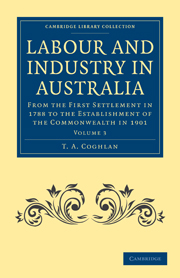 Labour and Industry in Australia
Labour and Industry in Australia Book contents
Summary
NEW SOUTH WALES
After the suspension of assisted immigration in 1868, New South Wales continued to attract some 2000 to 4000 persons yearly, chiefly from the neighbouring colonies; but with the return of good times about the beginning of this period, there was a demand for the revival of assisted immigration. When Parkes became Premier in May 1872 he determined to accede to this demand, and obtained from Parliament a vote of £50,000 for immigration purposes, which was available for expenditure during 1873. A new scheme was devised, under which mechanics, farmers, agricultural labourers, vine-dressers, and domestic servants were to receive assistance, the immigrant paying one-third of his passage to Sydney, and the colony paying the balance. The benefits of the scheme were to be confined to married persons not exceeding thirty-five years of age, and single women up to thirty years. There was a further restriction in regard to single women, namely, that the number assisted in any year should not exceed one-fifth of the total number of all classes. In order to prevent Irish Catholics coming to the colony in large numbers, the regulations provided that the proportion of immigrants of any religion should not exceed the proportion of persons professing that religion then in the colony to the whole population. The predilection of the governing authorities for Germans was shown by a provision allowing one-tenth of the immigrants to be of German nationality.
- Type
- Chapter
- Information
- Labour and Industry in AustraliaFrom the First Settlement in 1788 to the Establishment of the Commonwealth in 1901, pp. 1280 - 1330Publisher: Cambridge University PressPrint publication year: 2011First published in: 1918
